If a survey indicates that church attendance is increasing, why is this rise not seen in congregations and denominational figures?
I suggest the YouGov survey is picking up people in the church fringe, whose revival may feed into larger church attendance and membership in the future.
Quiet Revival
In April 2025, the Bible Society reported that a “quiet revival” is taking place in church attendance in England and Wales [1]. Specifically, they state
“… churchgoing Christians now make up 12% of the population, up from 8% in 2018” [1, The Quiet Revival Report, p. 6]
The Bible Society used evidence from two surveys conducted by YouGov in 2018 and 2024 that asked questions related to church-going, the Bible and social attitudes [1, report p. 10]. They admit their results will come as a surprise to many people, especially when those percentages are translated into actual church attendance. They claim that church attendance has increased from 3.7 million in 2018 to 5.8 million in 2024, representing an increase of over 50%.
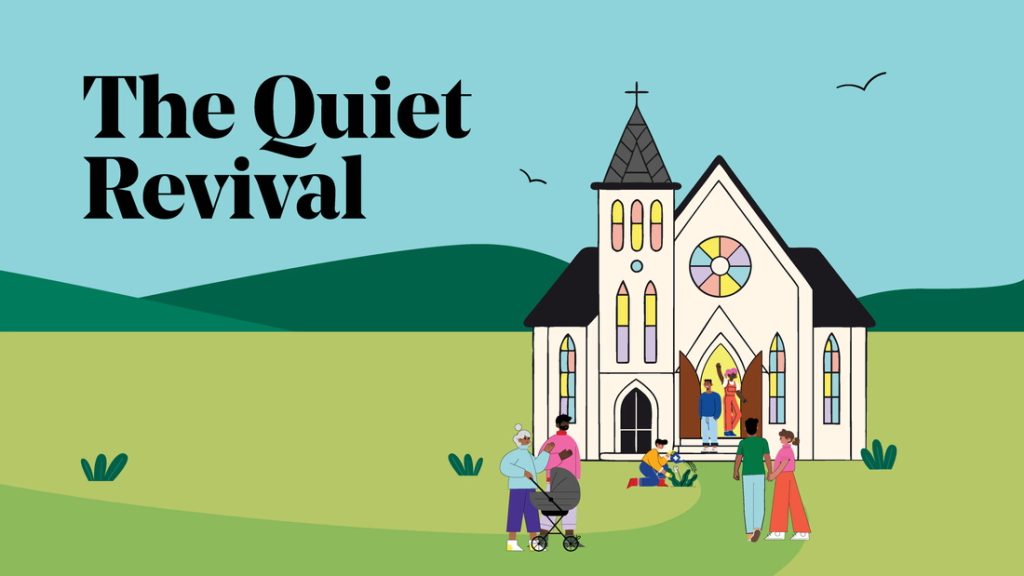
It is even more surprising to hear that the increase is mainly driven by the younger age groups. For example, 16% of adults aged 18-24 are churchgoers in 2024 compared with only 4% in 2018 [1, Report p. 16]. Churchgoing is defined as attending church at least once a month. This represents a remarkable turnaround among young people.
Good News
Clearly, the report is good news for a church where most denominations have experienced substantial decline for 60 years. Many media outlets and commentators have welcomed the news, with some eye-catching headlines about revival in Britain [2-6]. Others have taken a more measured approach, raising questions about the research, but reaching positive conclusions [7-9]. The report provides welcome confirmation of the anecdotal evidence that has been circulating for some time regarding increases in church attendance [10].
It is also worth noting that a biannual survey by YouGov has shown an increase in belief in God or gods over the last five years [11]. This increase is quite dramatic among young people, rising from 22% to 45% in the 18-24 age group. London is especially affected.
So, is this the revival for which we have been praying? Are we at last witnessing a spiritual outpouring in our country? Or is this an attempt to use incomplete evidence as a spin to cover the ongoing decline of the church?
Incomplete Evidence?
The report is not good news for everyone. Humanists UK has criticised the conclusions, claiming that they do not align with attendance figures as reported by Christian denominations [12]. They state:
This means it’s possible for us to calculate that for the Church of England, the survey reported monthly attendance figures as going from 1.5 million to 2 million – 30% growth. For the Catholic Church, numbers went from 850,000 to 1.8 million – an astonishing 112% growth! [12]
Humanists UK conclude that this poll is wildly out of step with known attendance figures. They could have gone further. The YouGov evidence, as interpreted by the Bible Society, contradicts the membership figures of most denominations. Indeed, it would not align with the lived experience of many congregations, whose members see only ageing and decline. Like Humanists UK, they could ask, “Where is this quiet revival? It is so quiet we can’t see it!”
These criticisms of the work are compelling and should be taken seriously. My article will address this.

A Quiet Revival
The title of the report is brilliant – “Quiet”. It suggests that this revival has been happening, and we have not noticed it!
When most people think of revival, they think of the big ones like the Welsh Revival of 1904-5, which saw 100,000 people added to the churches in Wales over 12 months [13-14]. Similarly, in 1859,120,000 were converted in Wales, with similarly large numbers added in Scotland, Northern Ireland and the USA [15].
However, these revivals were only fast and noticeable because churches comprised a substantial proportion of society. Most revivals are much slower. For example, the Methodists in the 18th century started very slowly in the 1730s, not really accelerating until the end of that century [16]. When the church represents a small proportion of society, its growth is slow and may not be noticed by most of the population [17]. Most revivals experience a quiet period first, sometimes lasting many years.
Nevertheless, the survey indicates “something” has increased by over 50% in 6 years. That is significant. So, why is this increase not observed in churches?
Membership and Attendance
The concepts of church membership and attendance do not align well with Christian history. Before the Reformation, no one would have considered themselves a “member” of a church. If they were baptised, they were Christian – that was it. No records! No list to join. Sunday attendance could be quite sporadic. Membership rolls emerged during the Protestant Reformation, and only for certain types of denominations [18]. National membership data began to be collected from the 19th century. Attendance figures have been regularly gathered only more recently, and there is no universally agreed-upon definition.
There are at least three concepts involved:
- Church Attendance. Individuals who regularly attend Christian worship, regardless of whether they are members or not
- Church Membership. Individuals listed as members of the congregation and/or its denomination, regardless of whether they attend or not.
- Church Fringe. Those who occasionally engage in church activities. They may consider themselves Christians in a cultural sense, or they may simply be drawn to Christianity. Perhaps they view themselves as believers but do not wish to attend Sunday worship regularly.
Outside these categories, there are cultural Christians who do not engage with the church at all. They may have had a church background but have now severed any contact. They might consider themselves Christian because of their Christian parents or because they live in a Christian country. Additionally, there are those who follow other religions or none at all. They consciously do not identify as Christians. They are not necessarily hostile toward Christianity, nor do they need to be atheists. This group includes those who are uncertain of their beliefs.
A Model
I will propose a model to explain the relationship between church fringe, membership, and attendance. I will use system dynamics to describe the movements between these categories, the three rectangles in Figure 1 [19]. These rectangles, known as stocks, represent the numbers in each category at any given time.
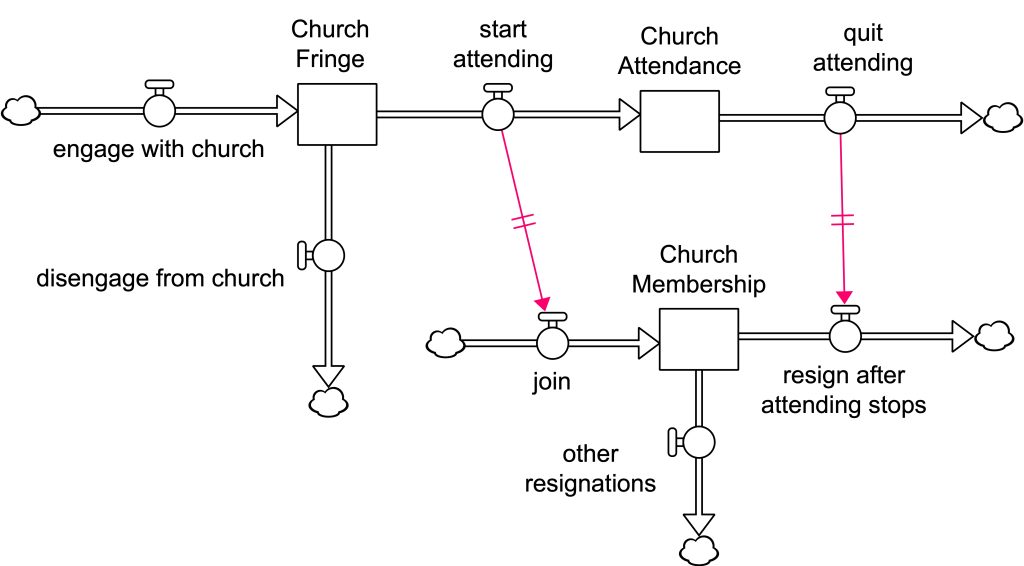
People who are not Christian may “engage with church”, the flow on the left, Figure 1. These people are added to the “Church Fringe” stock. I will not model any reasons why this occurs. This model will only explore what could happen in all three categories if there is an increase in people identifying with a Christian culture.
Some on the fringe may disengage from the church. They leave the “Church Fringe” stock, Figure 1. Some may start attending a church. Whether they are converted to Christianity, express personal faith, or are “saved” is beyond the scope of the model. The only measurables are attendance and membership. Additionally, some may quit attending church.
Some of those who start attending the church may become members after some time. This process is represented by the link from “start attending” to “join”, Figure 1. The two lines on the link indicate the delay between attending a church and becoming a member. Sources of delay include the time required for conversion, the progress of membership classes, and the periodic nature of adding members. Often, individuals who stop attending remain on the membership roll for some time before resigning or being removed, another source of delay, Figure 1. Of course, some may resign and carry on attending, represented by the flow “other resignations”.
A Thought Experiment.
I will begin the simulation in the year 2000. Imagine a small town with a population of 3000 people. Only 277 engage with the church in any capacity, of which just 68 attend Sunday services. The church has a membership of 90. Both attendance and membership are declining, and by 2020, these figures have dropped to 54 and 69, respectively (Figure 2). Membership often exceeds attendance in declining churches.
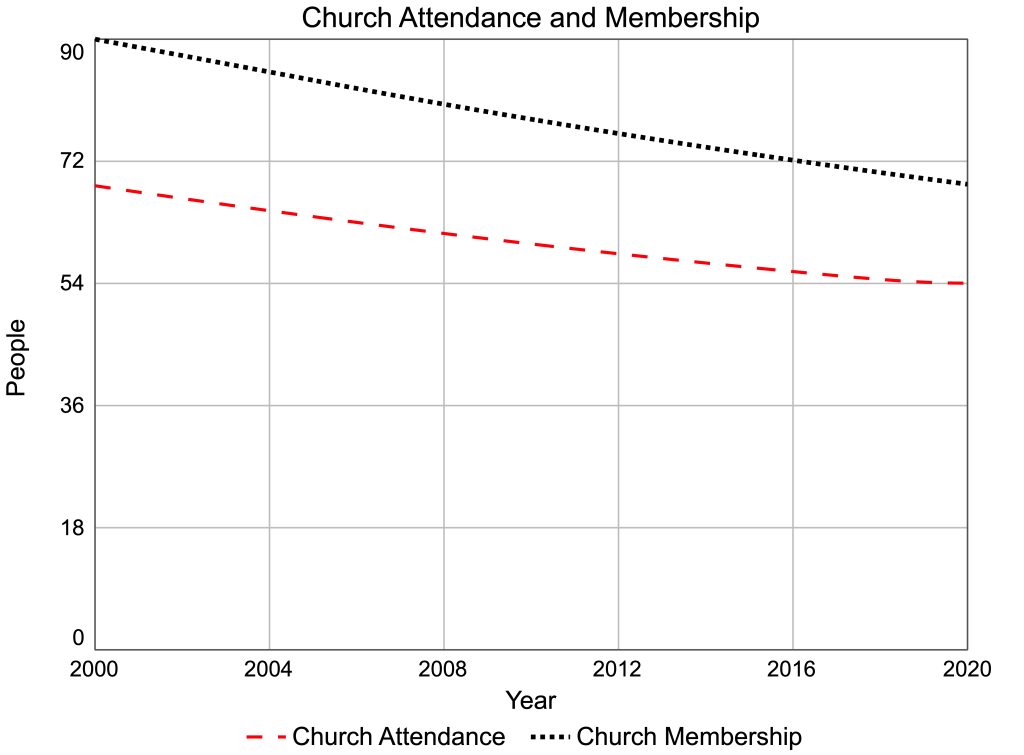
The church fringe is also declining. However, for some reason, interest in Christianity begins to increase in 2017, and more people start engaging with the church. Figure 3 shows the church fringe increasing from 2018. Although there is a corresponding increase in the wider church, church attendance is still declining in 2020, Figure 2. Not enough of the fringe have become regulars at church.
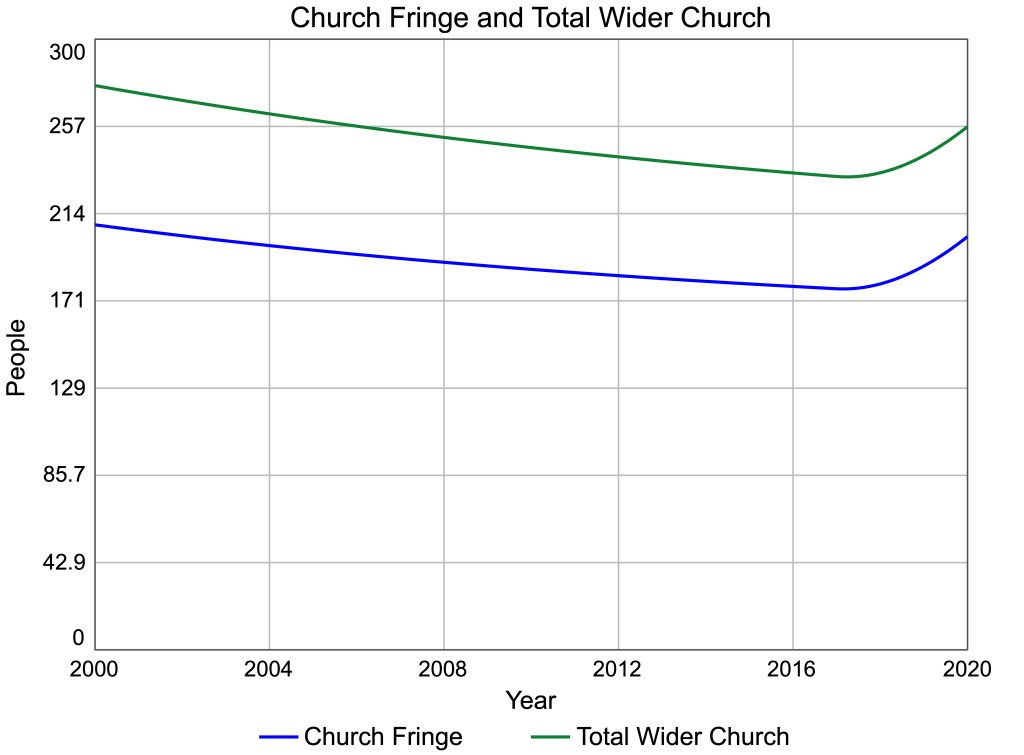
Compare the numbers in 2018 with those in 2024, the years of the YouGov polls, Figure 4. Because of the increase in the fringe, the wider church has jumped from nearly 8% to 12%, mirroring the result of the YouGov attendance poll. However, measured church attendance has barely increased (1.8% to 1.9%), and membership continues to decline. The three measures give three different pictures of the changes in church numbers, mainly due to delays in the system, Figure 1. The Church Fringe is at the front of a supply chain, while membership is at the end, taking longer to respond to changes of interest.
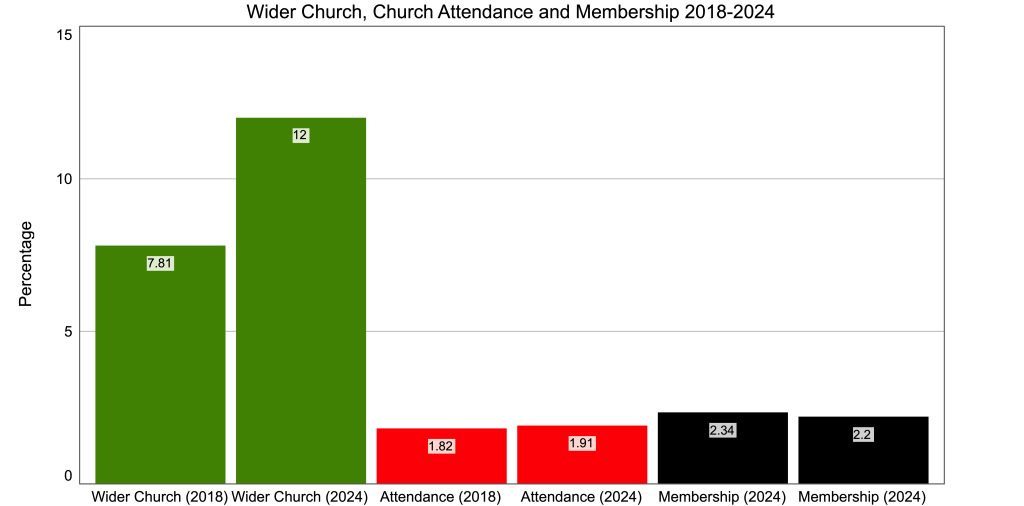
 Figure 4: Wider church, attendance and membership figures compared in the years of the YouGov Polls
Figure 4: Wider church, attendance and membership figures compared in the years of the YouGov PollsI suggest that the YouGov poll is picking up people in the church fringe as well as regular attenders.
Why Do Those in the Church Fringe Say They Attend Regularly?
You may object at this point and say that YouGov asked people if they attended church at least once a month. If fringe people claim they are attending, why is this not reflected in the church’s attendance figures?
- Church attendance figures only measure Sunday attendance. Fringe people may only attend midweek services. These services are popular among older people in Anglican churches. Young people may be attending their own events, not the main Sunday services. My own church regularly had 20 young people in church each week, but they were not in the main Sunday service, so they were never counted in our figures! We have a monthly messy church that is well attended. They do not count in our Sunday figures either.
- Some may attend Sunday service once a month. However, that only counts as 0.25 towards the official attendance figures when averaging or sampling takes place.
- Some may claim they attend at least once a month, as that is what it feels like to them. In reality, it is much less.
- Most denominations do not record attendance figures, only membership figures. These are at the end of the church supply chain, Figure 1, and take longer to respond to changes at the front.
- The increase in the fringe affects only a small number of congregations, those with a high community engagement and where God is moving. Even in the 1904-5 Welsh revival, when 100,000 were added to the churches in a year, many congregations saw none added.
- Many congregations experiencing increased attendance are independent, and their figures do not contribute to any denomination’s attendance totals.
I suspect that all these factors explain the mismatch between the YouGov figures and the feelings on the ground, as well as the official attendance figures.
Future 1 – The Quiet Revival Continues
If the model in Figure 1 is a reasonable explanation for changes in church participation between 2018 and 2024, what will the future hold if the increase in Christianity continues? Back to our thought experiment and the town of 3000 people. I will be pessimistic and say our congregation does not capitalise on the increase in its fringe. Instead, it simply waits for people to become regulars and join the church at the same per capita rate they did before. Figure 5 describes the changes up to 2050.
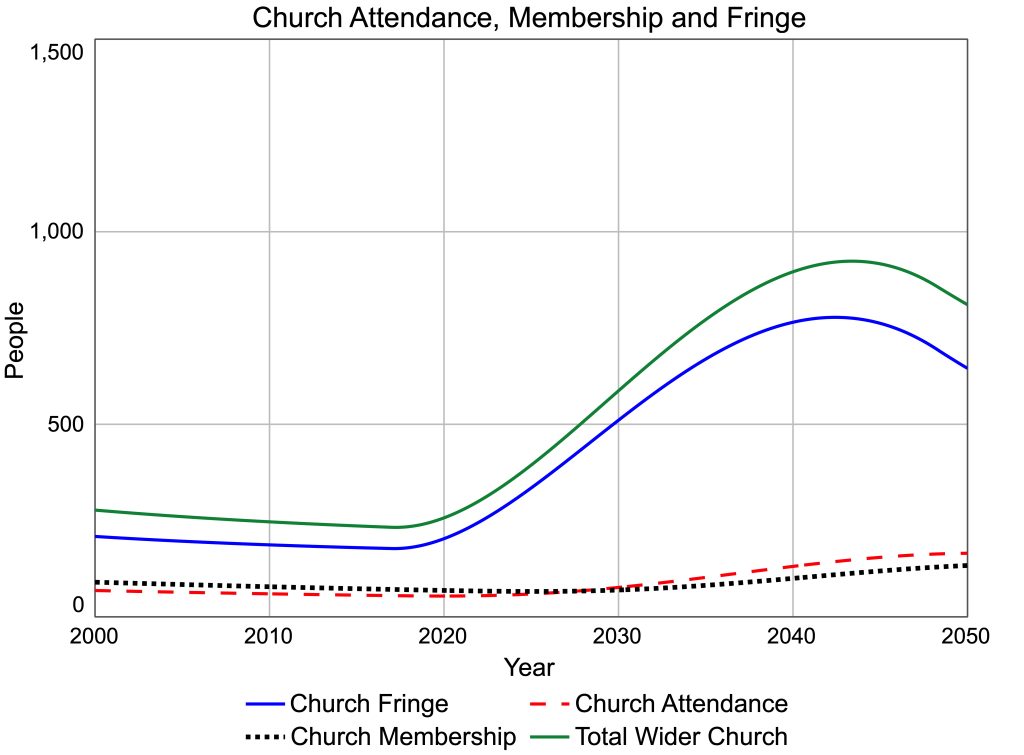
The church fringe continues to increase until the 2040s, after which the losses catch up with those who engage with the church, Figure 5. There is a corresponding rise in the wider church, but most of these people remain on the fringe and do not become church regulars or join. Nevertheless, there is a rise in official church attendance up to 160 by 2050, red dashed curve. The church has not only survived but nearly tripled in attendance. Likewise, membership has risen, black dotted curve. However, I doubt that the church would call this a revival. It has failed to benefit from the general increase in interest in Christianity. The quiet revival remains quiet.
Future 2 – The Quiet Revival Becomes Loud
This time, let me be optimistic and assume the church will intentionally contact people on the fringe, seeking to make them disciples. Initially, church attendance takes longer to rise because there are few in the church to make contact with those outside, Figure 6, and I have switched off the natural supply of new converts present in Future 1! However, as the church grows, they make more converts from the fringe and church attendance explodes in the late 2030s [20]. By 2050, the small church of 68 has 1000 in attendance, a third of the town. I think they will call this a revival! It is certainly revival growth, and I suspect it would take an outpouring of the Spirit on the church for them to make such effective contacts with people. The quiet revival has become loud!
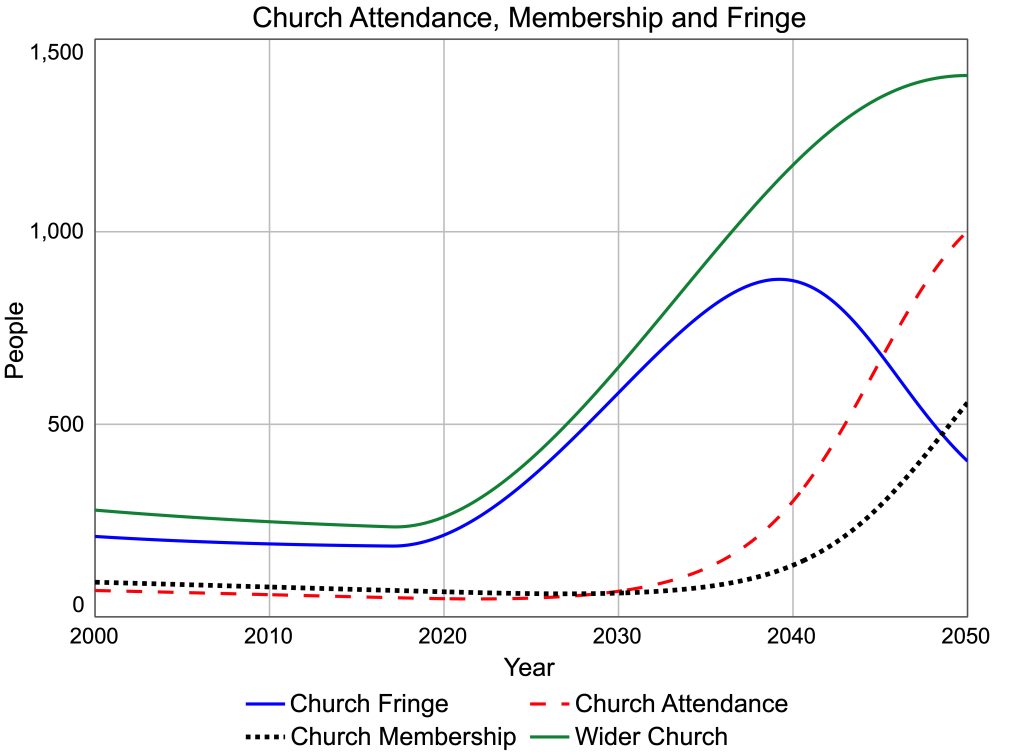
The church membership still lags behind attendance, Figure 6. Nevertheless, it has increased fivefold by 2050. The wider church has nearly become half the town, but it has reached its peak. The model in Figure 1 only explored the changes in church numbers given changes in the fringe. I have no feedback loop connecting church size to the flow, “engage with church”. If the church were to contact those outside the fringe, creating an interest in Christianity, then the revival could be larger and more sustained.
Outpouring of the Spirit
Such a loud revival is not possible if all the church does is hope that those who take an interest in Christianity find their way into the church. Revival includes an outpouring of the Spirit on the church. We need to be empowered to do what most congregations are currently not doing. This is why I, and many others, pray for revival. We need to change. We must become people who so long to see others become Christians, and by that, I mean “saved,” that we will “‘Go out into the highways and hedges, and compel them to come in’,” as our Lord said, Luke 14:23. That requires the Holy Spirit to fall upon us.
Conclusion
I have demonstrated that it is possible for a survey to indicate a significant rise in church attendance without this being reflected in actual church attendance and membership figures over the same period. Only time and further research will determine whether a genuine revival is occurring, whether quiet or loud. However, it should inspire us to prayer and action, and increase our faith in God, whom we believe desires to see His church flourish and His Son glorified.
Postscript
As I write this blog, I have just listened to “Any Questions” on BBC Radio 4. The panel members were asked: “Is the intense coverage of the death of Pope Francis an indication of a renewed interest in the Christian Faith?” The questioner and the panel referred to both the YouGov poll and the Bible Society’s research. All four politicians spoke positively about the Christian church and the increased interest in the Christian faith. Three mentioned that the Christian faith provides meaning and purpose in life, and that its recovery is beneficial [21].
Normally, politicians are very apologetic about or disinterested in Christian matters. Perhaps the growing interest among young people, along with the encouraging reports from the Bible Society and others, is prompting more people to engage with the church, completing the feedback loop between church size and joining the church fringe I mentioned earlier. Is the tide turning? Has the wind started blowing?
References and Notes
- The Quiet Revival: Gen Z leads rise in church attendance. The Bible Society, April 2025.
- “The Quiet Revival” of church attendance fuelled by Gen Z. Religion Media Centre, 8/4/25.
- ‘Quiet Revival’ sweeps the UK, as church attendance soars. Premier Christian News 8/4/2025.
- ‘Dramatic growth’ in church attendance by young people, Bible Society research finds, Church Times, 8/4/2025.
- The UK is experiencing a quiet revival. It’s taken me by surprise. Premier Christianity 9/4/25.
- England and Wales: 56% more go to church than 7 years ago, Evangelical Focus, 10/4/25.
- A quiet UK revival? How can we respond? Evangelicals Now, 9/4/25.
- Is there a ‘Quiet Revival’ taking place in England and Wales? Ian Paul, Psephizo, 17/4/25.
- A Quiet UK Revival? Issachar People, 24/4/25.
- See, for example, John Stevens’ article: The ‘Quiet Revival’ Breaks Spiritual Stillness in the United Kingdom. The Gospel Coalition, 11/4/25.
- Brits’ beliefs about God(s). Biannual survey by YouGov 2019-2024.
- Gen Z ‘religious revival’? The evidence is incomplete. Humanists UK, 10/4/25
- 1904-5 Welsh Revival and Limited Enthusiasm, Church Growth Modelling.
- Evans E. (1969). The Welsh Revival of 1904. Evangelical Press of Wales.
- Edwards B.H. (1990). Revival! Evangelical Press.
- Note figure 2 in The Rise and Decline of British Methodism, Church Growth Modelling.
- See page 21 of Mathematical Modeling of Church Growth. John Hayward. Journal of Mathematical Sociology. 23(4), 255-292, 1999.
- Baptists and Congregationalists need membership rolls as each member is equal in decision-making within a congregation. By contrast, the Anglican church has a very loosely defined “electoral roll”. Only recently have they tried to link the figure to regular participation, hence its unreliability over time.
- For an introduction to system dynamics, also called stock-flow modelling see:
• Introduction to System Dynamics for Those Interested in Church Growth, Church Growth Modelling, 2020.
• James Madison University, System Dynamics Course
• Sociomechanics, my other website. - The feedback mechanism is , the more enthusiasts, the more converts, thus, more enthusiasts. Enthusiasts are the subset of the church responsible for making converts, the ones on who the Spirit has fallen. See my explnation of the Limited Enthusiasm Model.
- Any Questions, BBC Radio 4, 25/4/25. Available on BBC Sounds for over a year. The panel were: Jess Brown-Fuller MP (LibDem), John Glen MP (Conservative), Baroness Angela Smith (Labour) and Gawain Towler (Reform).
Tags: Bible Society, Church Fringe, Humanists UK, Quiet Revival
Thanks for this interesting and thoughtful piece.
I am responsible for collecting, checking, collating, and publishing the Church of England’s attendance and participation statistics, reported directly by churches. The most recent figures are publicly available here: https://www.churchofengland.org/sites/default/files/2024-12/statisticsformission2023.pdf
Readers might be interested to know that the Church of England statistics do include attendance at midweek services, and at fresh expressions of church (which would include Messy Church); we also have a measure called “worshipping community” which is – approximately – the number of people who attend worship at least one a month (in person or, since Covid, online or mixed).
Trends for all our various measures are not identical to each other – it would be strange if they were, since they measure different things – but by all measures attendance and participation were lower in 2023 than in 2018.
I would welcome a chance to chat about some of this with you, if that would be interesting; do let me know if so.
Hi Ken
Thank you for the clarification about the stats on the different worshipping communities in the C of E. I would be happy to have a chat with you about these issues. I will send an email to the one you used to post here and we can fix something up.
Pingback: You Don’t Measure Revival by Data - Church Growth Modelling